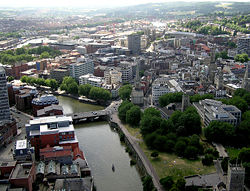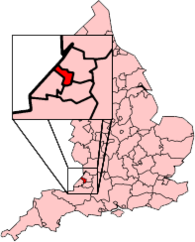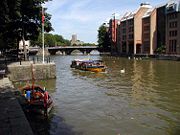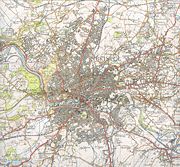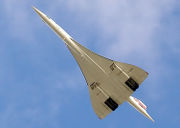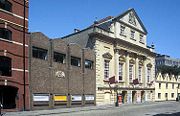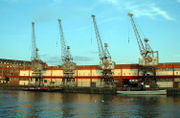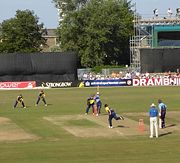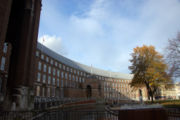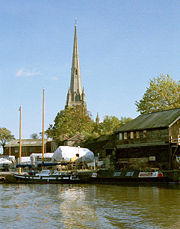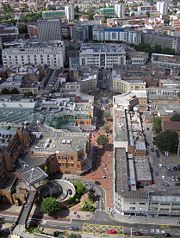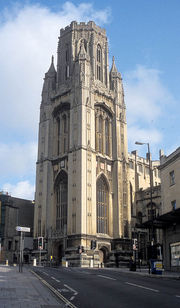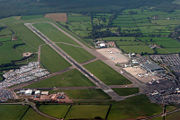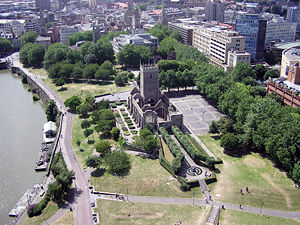Bristol
2008/9 Schools Wikipedia Selection. Related subjects: British Cities; Great Britain
| Bristol | |||
| Bristol Bridge and the River Avon | |||
|
|||
| Coordinates: | |||
|---|---|---|---|
| Sovereign state | United Kingdom | ||
| Constituent country | England | ||
| Region | South West England | ||
| Ceremonial county Historic counties |
Bristol County corporate ( Gloucestershire and Somerset) Avon |
||
| Admin HQ | Bristol | ||
| Royal Charter | 1155 | ||
| County status | 1373 | ||
| Government | |||
| - Type | Unitary authority, City | ||
| - Governing body | Bristol City Council | ||
| - Leadership | Leader & Cabinet | ||
| - Executive | Labour | ||
| - MPs | Roger Berry (L) Kerry McCarthy (L) |
||
| Area | |||
| - Unitary & City | 42.5 sq mi (110 km²) | ||
| Elevation | 36 ft (11 m) | ||
| Population (2006 est.) | |||
| - Unitary & City | 410,500 ( Ranked 43rd) | ||
| - Density | 9,425/sq mi (3,639/km²) | ||
| - Urban | 441,556 | ||
| - Metro | 551,066 | ||
| - Ethnicity | 89.3% White 3.9% S. Asian 2.8% Black 2.2% Mixed Race 1.8% E. Asian or Other |
||
| Time zone | GMT ( UTC0) | ||
| Postcode | BS | ||
| Area code(s) | 0117 | ||
| ISO 3166-2 | GB-BST | ||
| ONS code | 00HB | ||
| OS grid reference | ST5946972550 | ||
| NUTS 3 | UKK11 | ||
| Website: www.bristol.gov.uk/ | |||
Bristol ( pronunciation ; pronounced /ˈbrɪstəl/) is a city, unitary authority and ceremonial county in South West England, 105 miles (169 km) west of London, and 44 miles (71 km) east of Cardiff.
With an approximate population of 410,950, and urban area of 550,200, it is England's sixth, and the United Kingdom's ninth most populous city, one of England's core cities and the most populous city in South West England. It received a royal charter in 1155 and was granted county status in 1373. For half a millennium it was the second or third largest English city, until the rapid rise of Liverpool, Birmingham and Manchester in the Industrial Revolution during the latter part of the 18th century. It borders the counties of Somerset and Gloucestershire, lying between the cities of Bath, Gloucester and Newport, and has a short coastline on the estuary of the River Severn, which flows into the Bristol Channel.
Bristol is the largest centre of culture, employment and education in the region. From its earliest days, its prosperity has been linked to that of the Port of Bristol, the commercial port, which was in the city centre but has now moved to the Severn Estuary coast at Avonmouth and Portbury, to the western extent of the city boundary. In more recent years the economy has been built on the aerospace industry and the city centre docks have been regenerated as a centre of heritage and culture.
Boundaries
There are a number of different ways in which Bristol's boundaries are defined, depending on whether the boundaries attempt to define the city, the built-up area, or the wider " Greater Bristol". The narrowest definition of the city is the city council boundary; although this definition does include a large portion of the Severn Estuary, west as far as the islands of Steep Holm and Flat Holm. A slightly less narrow definition is used by the Office for National Statistics; this includes built-up areas which adjoin Bristol but are not within the city council boundary, such as Whitchurch village, Filton, Patchway, Bradley Stoke, and excludes non-built-up areas within the city council boundary. The ONS has also defined an area which it calls the "Bristol Urban Area" which includes Kingswood, Mangotsfield, Stoke Gifford, Winterbourne, Frampton Cotterell, Almondsbury and Easton-in-Gordano. The term "Greater Bristol" (used for example by the Government Office of the South West is most usually used to refer to the area covered by the city and its three neighbouring local authorities
History
60,000-year-old archaeological finds at Shirehampton and St Annes provide evidence of settlement in the Bristol area from the palaeolithic era. There are Iron Age hill forts near the city, at Leigh Woods and Clifton Down on the side of the Avon Gorge, and on Kingsweston Hill, near Henbury. During the Roman era there was a settlement, Abona, at what is now Sea Mills, connected to Bath by Roman road, and another settlement at what is now Inns Court. There were also isolated Roman villas and small Roman forts and settlements throughout the area. The town of Brycgstow (Old English, "the place at the bridge") was in existence by the beginning of the 11th century, and under Norman rule acquired one of the strongest castles in southern England.

The River Avon in the city centre has evolved into Bristol Harbour, and from the 12th century the harbour was an important port, handling much of England's trade with Ireland. In 1247 a new bridge was built, which was replaced by the current Bristol Bridge in the 1760s, and the town was extended to incorporate neighbouring suburbs, becoming in 1373 a county in its own right. During this period Bristol also became a centre of shipbuilding and manufacturing. Bristol was the starting point for many important voyages, notably John Cabot's 1497 voyage of exploration to North America.
By the 14th century Bristol was England's third-largest medieval town (after London and York), with perhaps 15,000–20,000 inhabitants on the eve of the Black Death of 1348–49. The Plague inflicted a prolonged pause in the growth of Bristol's population, with numbers remaining at 10,000–12,000 through most of the 15th and 16th centuries. The Diocese of Bristol was founded in 1542, with the former Abbey of St. Augustine becoming Bristol Cathedral. Traditionally this is equivalent to the town being granted city status. During the 1640s English Civil War the city was occupied by Royalist military, after they overran Royal Fort, the last Parliamentarian stronghold in the city.
Renewed growth came with the 17th century rise of England's American colonies and the rapid 18th century expansion of England's part in the Atlantic trade in Africans taken for slavery in the Americas. Bristol, along with Liverpool, became a centre for the slave trade although few slaves were brought to Britain. During the height of the slave trade, from 1700 to 1807, more than 2,000 slaving ships were fitted out at Bristol, carrying a (conservatively) estimated half a million people from Africa to the Americas and slavery. Still standing in Bristol is the Seven Stars pub, where abolitionist Thomas Clarkson collected information regarding the slave trade.
Fishermen who left Bristol were long part of the migratory fishery to the Grand Banks of Newfoundland and began settling that island permanently in larger numbers around this time. Bristol's strong nautical ties meant that maritime safety was an important issue in the city, in the 19th century Samuel Plimsoll, "the sailor's friend", campaigned to make the seas safer. He was shocked by the overloaded cargoes and successfully fought for a compulsory load line on ships.
Competition from Liverpool from c. 1760, the disruption of maritime commerce through wars with France (1793) and the abolition of the slave trade (1807) contributed to the city's failure to keep pace with the newer manufacturing centres of the North of England and the West Midlands. The passage up the heavily tidal Avon Gorge, which had made the port highly secure during the Middle Ages, had become a liability which the construction of a new " Floating Harbour" (designed by William Jessop) in 1804–9 failed to overcome. Nevertheless, Bristol's population (66,000 in 1801) quintupled during the 19th century, supported by new industries and growing commerce. It was particularly associated with the Victorian era engineer Isambard Kingdom Brunel, who designed the Great Western Railway between Bristol and London Paddington, two pioneering Bristol-built ocean going steamships, the SS Great Britain and SS Great Western, and the Clifton Suspension Bridge. John Wesley founded the very first Methodist Chapel, called the New Room, in Bristol in 1739. Riots occurred in 1793 and 1831, the first beginning as a protest at renewal of an act levying tolls on Bristol Bridge, and the latter after the rejection of the second Reform Bill.
Bristol's city centre suffered severe damage from Luftwaffe bombing during the Bristol Blitz of World War II. The original central shopping area, near the bridge and castle, is now a park containing two bombed out churches and some tiny fragments of the castle. A third bombed church nearby, St Nicholas, has been restored and has been made into a museum which houses a triptych by William Hogarth, painted for the high altar of St Mary Redcliffe in 1756. The museum also contains statues moved from Arno's Court Triumphal Arch, of King Edward I and King Edward III taken from Lawfords' Gate of the city walls when they were demolished around 1760 and 13th century figures from Bristol's Newgate representing Robert, the builder of Bristol Castle, and Geoffrey de Montbray, Bishop of Coutances, builder of the fortified walls of the city.
The rebuilding of Bristol city centre was characterised by large, cheap 1960s tower blocks, brutalist architecture and expansion of roads. Since the 1980s another trend has emerged with the closure of some main roads, the restoration of the Georgian period Queen Square and Portland Square, the demolition and rebuilding of the Broadmead Shopping Centre (at 2007 in progress) and the demolition of the city centre's tallest post-war blocks.
The removal of the docks to Avonmouth, 7 miles (11.3 km) downstream from the city centre has also allowed redevelopment of the old central dock area (the " Floating Harbour") in recent decades, although at one time the continued existence of the docks was in jeopardy as it was viewed as a derelict industrial site rather than an asset. However the holding, in 1996, of the first International Festival of the Sea in and around the docks, affirmed the dockside area in its new leisure role as a key feature of the city..
Economy and industry
As a major seaport, Bristol has a long history of trading commodities, particularly tobacco; deals were frequently struck on a personal basis in the former trading area around Corn Street, and in particular, over metal trading tables, known as "The Nails". This is the origin of the expression "cash on the nail", meaning immediate payment.
As well as Bristol's nautical connections, the city's economy is reliant on the aerospace industry, the media, information technology and financial services sectors and tourism. In 2004 Bristol's GDP was £9.439 billion GBP, and the combined GDP of Gloucestershire, Wiltshire and North Somerset was £44.098 billion. The GDP per head was £23,962 (US$47,738, €35,124) making the city more affluent than the UK as a whole, at 40% above the national average. This makes it the third-highest per-capita GDP of any English city, after London and Nottingham, and the fifth highest GDP per capita of any city in the United Kingdom, behind London, Edinburgh, Belfast and Nottingham. In December 2005, Bristol's unemployment rate was 5.2%, compared with 3.6% for the south west and 4.8% for the United Kingdom.
While Bristol's economy is no longer reliant upon its port, the city is the largest importer of cars to the UK. Since the port was leased in 1991, £330 million has been invested and the annual tonnage throughput has increased from 4 million tonnes to 12 million tonnes. The financial services sector employs 40,000 in the city, and the hi-tech sector is important, with 400 micro-electronics and silicon design companies, as well as the Hewlett-Packard national research laboratories. Bristol is the UK's seventh most popular destination for foreign tourists, and the city receives nine million visitors each year.
In the 20th century, Bristol's manufacturing activities expanded to include aircraft production at Filton, by the Bristol Aeroplane Company, and aero-engine manufacture by Bristol Aero Engines (later Rolls-Royce) at Patchway. The aeroplane company became famous for the World War I Bristol Fighter, and Second World War Blenheim and Beaufighter aircraft. In the 1950s it became one of the country's major manufacturers of civil aircraft, with the Bristol Freighter and Britannia and the huge Brabazon airliner. The Bristol Aeroplane Company diversified into car manufacturing in the 1940s, producing hand-built luxury cars at their factory in Filton, under the name Bristol Cars, which became independent from the Bristol Aeroplane Company in 1960. The city also gave its name to the Bristol make of buses, manufactured in the city from 1908 to 1983, first by the local bus operating company, Bristol Tramways, and from 1955 by Bristol Commercial Vehicles.
In the 1960s Filton played a key role in the Anglo-French Concorde supersonic airliner project. Concorde components were manufactured in British and French factories and shipped to the two final assembly plants, in Toulouse and Filton. The French manufactured the centre fuselage and centre wing and the British the nose, rear fuselage, fin and wingtips, while the Olympus 593 engine's manufacture was split between Rolls-Royce (Filton) and SNECMA (Paris). The British Concorde prototype made its maiden flight from Filton to RAF Fairford on 9 April 1969, five weeks after the French test flight. In 2003 British Airways and Air France decided to cease flying the aircraft and to retire them to locations (mostly museums) around the world. On 26 November 2003 Concorde 216 made the final Concorde flight, returning to Filton airfield to be kept there permanently as the centrepiece of a projected air museum. This museum will include the existing Bristol Aero Collection, which includes a Bristol Britannia aircraft.
The aerospace industry remains a major segment of the local economy The major aerospace companies in Bristol now are BAE Systems, Airbus and Rolls-Royce, all based at Filton, and aerospace engineering is a prominent research area at nearby UWE. Another important aviation company in the city is Cameron Balloons, a manufacturer of hot air balloons. Each August the city is host to the Bristol International Balloon Fiesta, one of Europe's largest hot air balloon events.
Culture
Arts
The city is famous for its music and film industries, and was a finalist for the 2008 European Capital of Culture.
The city's principal theatre company, the Bristol Old Vic, was founded in 1946 as an offshoot of the Old Vic company in London. Its premises on King Street consist of the 1766 Theatre Royal (400 seats), a modern studio theatre called the New Vic (150 seats), and foyer and bar areas in the adjacent Coopers' Hall (built 1743). The Theatre Royal is a grade I listed building and was the oldest continuously operating theatre in England. The Bristol Old Vic Theatre School, which had originated in King street is now a separate company. The Bristol Hippodrome is a larger theatre (1981 seats) which hosts national touring productions, while the 2000-seat Colston Hall, named after Edward Colston, is the city's main concert venue. Other theatres include the Tobacco Factory, QEH and Redgrave Theatre (at Clifton College). Bristol's theatre scene includes a large variety of theatre companies, an organisation called Theatre Bristol runs a website which aims to develop the theatre industry in Bristol, this website lists 82 different theatre companies operating within the city. There are also a number of organisation within the city which act to support theatre makers, for example Equity, the actors union, has a General Branch based in the city and there is an organisation called Residence which provides office, social and rehearsal space for several Bristol based theatre and performance companies.
Since the late 1970s, the city has been home to bands combining punk, funk, dub and political consciousness, the most celebrated being The Pop Group. Ten years later, Bristol was the birthplace of a type of English hip-hop music called trip hop or the "Bristol Sound", from artists such as Tricky, Portishead, Smith & Mighty and Massive Attack. It is also a stronghold of drum & bass with notable artists such as the Mercury Prize winning Roni Size/ Reprazent as well as the pioneering DJ Krust and More Rockers. This music is part of the wider Bristol urban culture scene which received international media attention in the 1990s. Bristol is home to many live music venues, including Fiddlers, Victoria Rooms, St George's and a range of pubs from the jazz orientated The Old Duke to rock at the Fleece and Firkin and indie bands at the Louisiana.
The Bristol City Museum and Art Gallery houses a collection of natural history, archaeology, local glassware, Chinese ceramics and art. The Bristol Industrial Museum, featuring preserved dock machinery, closed in October 2006 for rebuilding and plans to reopen in 2011 as the Museum of Bristol The City Museum also runs three preserved historic houses: the Tudor Red Lodge, the Georgian House, and Blaise Castle House. The Watershed Media Centre and Arnolfini gallery, both in disused dockside warehouses, exhibit contemporary art, photography and cinema, while the city's oldest gallery is at the Royal West of England Academy in Clifton.
Stop frame animation films and commercials produced by Aardman Animations and television series focusing on the natural world have also brought fame and artistic credit to the city. The city is home to the regional headquarters of BBC West, and the BBC Natural History Unit. Locations in and around Bristol often feature in the BBC's natural history programmes, including the children's television programme Animal Magic, filmed at Bristol Zoo.
In literature Bristol is noted as the birth place of the 18th century poet Thomas Chatterton, and the poets Robert Southey, who was born in Wine Street, Bristol in 1774, and Samuel Taylor Coleridge married the Bristol Fricker sisters; and William Wordsworth spent time in the city where Joseph Cottle first published Lyrical Ballads in 1798.
The 18th and 19th century portrait painter Sir Thomas Lawrence and 19th century architect Francis Greenway, designer of many of Sydney's first buildings, came from the city, and more recently the graffiti artist Banksy. Some famous comedians are locals, including Justin Lee Collins, Lee Evans, and writer/comedian Stephen Merchant.
Bristol University graduates include magician and psychological illusionist Derren Brown; the satirist Chris Morris; Simon Pegg and Nick Frost of Spaced, Shaun of the Dead and Hot Fuzz; and Matt Lucas and David Walliams of Little Britain fame. Hollywood actor Cary Grant was born in the city; Patrick Stewart, Jane Lapotaire, Pete Postlethwaite, Jeremy Irons, Greta Scacchi, Miranda Richardson, Helen Baxendale, Daniel Day-Lewis and Gene Wilder are amongst the many actors who learnt their craft at the Bristol Old Vic Theatre School, opened by Sir Laurence Olivier in 1946. Hugo Weaving studied at Queen Elizabeth's Hospital School and David Prowse ( Darth Vader, Star Wars) attended Bristol Grammar School.
Sport and leisure
The city has two League football clubs: Bristol City and Bristol Rovers, as well as a number of non-league clubs, most notably Bristol Manor Farm. Bristol City are the most popular team in the city and were promoted to the second tier of English football in 2007. City recently lost in the play-off final of the Championship to Hull City (2007/2008 season). City announced plans for a new 30,000 all seater stadium to replace their home, Ashton Gate. Bristol Rovers, are the oldest professional football team in Bristol, formed in 1883. Rovers are just below mid-table in League One, and reached the Quarter-Final stage of the FA Cup. During their history, Rovers have been Champions of the (old) division Three (1952/53, 1989/90), Watney Cup Winners (1972, 2006/07), and runners-up in the Johnstone's Paint Trophy. The Club have planning permission to re-develop the Memorial Stadium into an 18,500 All-seater Stadium to be completed by December 2010.
The city is also home to Bristol Rugby rugby union club, a first-class cricket side, Gloucestershire C.C.C. and a Rugby League Conference side, the Bristol Sonics. The city also stages an annual half marathon, and in 2001 played host to the World Half Marathon Championships. There are several athletics clubs in Bristol, including Bristol and West AC, Bitton Road Runners and Westbury Harriers. Speedway racing was staged, with breaks, at the Knowle Stadium from 1928 to 1960, when it was closed and the site redeveloped. The sport briefly returned to the City in the 1970s when the Bulldogs raced at Eastville Stadium.
In summer the grounds of Ashton Court to the west of the city play host to the Bristol International Balloon Fiesta, a major event for hot-air ballooning in the UK. The Fiesta draws a substantial crowd even for the early morning lift that typically begins at about 6.30 am. Events and a fairground entertain the crowds during the day. A second mass ascent is then made in the early evening, again taking advantage of lower wind speeds. Ashton Court also plays host to the Ashton Court festival each summer, an outdoors music festival which used to be known as the Bristol Community Festival.
Dialect
A dialect of English is spoken by some Bristol inhabitants, known colloquially as Bristolian. Bristol is the only large English city with a rhotic accent, in which the r in words like car is pronounced. The unusual feature of this dialect, unique to Bristol, is the Bristol L (or terminal L), in which an L sound is appended to words that end in an 'a' or 'o'. Thus "area" becomes "areal", etc. This is believed to be how the city's name evolved from Brycgstow to have a final 'L' sound: Bristol. Further Bristolian linguistic features are the addition of a superfluous "to" in questions relating to direction or orientation (a feature also common to the coastal towns of South Wales), or using "to" instead of "at"; and using male pronouns "he", "him" instead of "it". For example, "Where's that?" would be phrased as "Where's he to?", a structure exported to Newfoundland English.
Stanley Ellis, a dialect researcher, found that many of the dialect words in the Filton area were linked to work in the aerospace industry. He described this as "a cranky, crazy, crab-apple tree of language and with the sharpest, juiciest flavour that I've heard for a long time".
A (slightly tongue in cheek) guide to Bristol's dialect is at http://www.thatbebristle.co.uk/
Politics and government
Bristol City Council consists of 70 councillors representing 35 wards. They are elected in thirds with two councillors per ward, each serving a four-year term. Wards never have both councillors up for election at the same time, so effectively two-thirds of the wards are up each election. The Council has long been dominated by the Labour Party, but recently the Liberal Democrats have grown strong in the city and as the largest party took minority control of the Council at the 2005 election. They are no longer in control following Labour and the Conservatives vetoing the Liberal Democrats' preferred candidate, Steve Comer, in 2007. As a result, Labour rule the council under a minority administration, and the council leader is Helen Holland. The Lord Mayor is Lib Dem Councillor Chris Davis.
Bristol's constituencies in the House of Commons cross the borders with neighbouring authorities, and the city is divided into Bristol West, East, South and North-west and Kingswood. Northavon also covers some of the suburbs, but none of the administrative county. At the next General Election, the boundaries will be changed to coincide with the county boundary. Kingswood will no longer cover any of the county, and a new Filton and Bradley Stoke constituency will include the suburbs in South Gloucestershire. There are four Labour and one Liberal Democrat Members of Parliament.
Bristol has a tradition of local political activism, and has been home to many important political figures. Tony Benn, a veteran left-wing politician, was Member of Parliament (MP) for Bristol South East from 1950 to 1983. Edmund Burke, MP for the Bristol constituency for six years from 1774, famously insisted that he was a Member of Parliament first, rather than a representative of his constituents' interests. In 1963, there was a boycott of the city's buses after the Bristol Omnibus Co. refused to employ black drivers and conductors. The boycott is known to have influenced the creation of the UK's Race Relations Act in 1965. The women's rights campaigner Emmeline Pethick-Lawrence (1867–1954) was born in Bristol. The city was the scene of the first of the 1980s riots or uprisings. In St. Paul's, a number of largely African-Caribbean people rose up against racism, police harassment and mounting disatifisfaction with their social and economic circumstances before similar disturbances followed across the UK. Local support of fair trade issues was recognised in 2005 when Bristol was granted Fairtrade City status.
Bristol is unusual in having been a city with county status since medieval times. The county was expanded to include suburbs such as Clifton in 1835, and it was named a county borough in 1889, when the term was first introduced. However, on 1 April 1974, it became a local government district of the short-lived county of Avon. On 1 April 1996, it once again regained its independence and county status, when the county of Avon was abolished and Bristol became a Unitary Authority.
Demographics
In 2005 the Office for National Statistics estimated Bristol's population at 398,300, making it the 47th-largest ceremonial county in England. Using Census 2001 data the ONS estimated the population of the contiguous built-up area to be 441,556, and that of the metropolitan area to be 551,066. This makes the city England's sixth most populous city, and ninth most populous metropolitan area. At 3,599 inhabitants per square kilometre (9,321 /sq mi) it has the seventh-highest population density of any English district.
According to 2005 estimates, 89.3% of the population were described as white, 3.9% as Asian or Asian British, 2.8% as black or black British, 2.2% as mixed race, 1.2% as Chinese and 0.6% other. National averages for England were 89.1%, 5.3%, 2.7%, 1.6%, 0.7% and 0.6% for the same groups. 60% of Bristol's population registered their religion as Christianity, and 25% as not religious in the 2001 census, compared with 72% and 15% nationally. 2% of the population follow Islam (3% nationally), with no other religion above one percent. Bristol had the ninth highest proportion of people refer to their religion in the last census as ' Jedi'.
Physical geography

Bristol is in a limestone area, which runs from the Mendip Hills to the south and the Cotswolds to the north east. The rivers Avon and Frome cut through this limestone to the underlying clays, creating Bristol's characteristic hilly landscape. The Avon flows from Bath in the east, through flood plains and areas which were marshy before the growth of the city. To the west the Avon has cut through the limestone to form the Avon Gorge, partly aided by glacial meltwater after the last ice age. The gorge aided in the protection of Bristol Harbour, and has been quarried for stone to build the city. The land surrounding the gorge has been protected from development, as The Downs and Leigh Woods. The gorge and estuary of the Avon form the county's boundary with North Somerset, and the river flows into the Bristol Channel at Avonmouth at the mouth of the River Severn. There is another gorge in the city, in the Blaise Castle estate to the north.
Situated in the south of the country, Bristol is one of the warmest cities in the UK, with a mean annual temperature of 10.2-12 ° C (50-54°F). It is also amongst the sunniest, with 1541-1885 hours sunshine per year. The city is partially sheltered by Exmoor and the Mendip Hills, but exposed from the Bristol Channel, and annual rainfall is similar to the national average, at 741-1,060 mm (29.2–41.7 in).
| Weather averages for Bristol, England, United Kingdom | |||||||||||||
|---|---|---|---|---|---|---|---|---|---|---|---|---|---|
| Month | Jan | Feb | Mar | Apr | May | Jun | Jul | Aug | Sep | Oct | Nov | Dec | Year |
| Average high °C (°F) | 8 (46) | 7 (45) | 10 (50) | 12 (54) | 17 (62) | 19 (66) | 22 (71) | 21 (69) | 18 (65) | 14 (57) | 11 (51) | 8 (47) | 14 (57) |
| Average low °C (°F) | 3 (38) | 3 (37) | 5 (41) | 6 (42) | 9 (48) | 12 (54) | 14 (58) | 14 (57) | 12 (53) | 9 (48) | 6 (43) | 4 (40) | 8 (47) |
| Precipitation mm (inches) | 142.3 (5.6) | 127.6 (5.02) | 133.6 (5.26) | 104.3 (4.11) | 76.9 (3.03) | 57.2 (2.25) | 48.9 (1.93) | 37.6 (1.48) | 82.5 (3.25) | 123.7 (4.87) | 154.8 (6.09) | 147.3 (5.8) | 1,236.7 (48.69) |
| Source: Weatherbase 2007- 08-03 | |||||||||||||
| Source #2: Met Office- Yeovilton 2007- 08-03 | |||||||||||||
Education, science and technology

Bristol is home to two major institutions of higher education: the University of Bristol, a " redbrick" chartered in 1909, and the University of the West of England, formerly Bristol Polytechnic, which gained university status in 1992. The city also has two dedicated further education institutions, City of Bristol College and Filton College, and three theological colleges, Trinity College, Wesley College and Bristol Baptist College. The city has 129 infant, junior and primary schools, 17 secondary schools, and three city learning centres. It has the country's second highest concentration of independent school places, after an exclusive corner of north London. The independent schools in the city include Colston's School, Clifton College, Clifton High School, Badminton School, Bristol Cathedral School, Bristol Grammar School, Redland High School, Queen Elizabeth's Hospital (the only all-boys school) and Red Maids' School, which is the oldest girls' school in England and was founded in 1634 by John Whitson.
In 2005, the then Chancellor of the Exchequer recognised Bristol's ties to science and technology by naming it one of six "science cities", and promising funding for further development of science in the city, with a £300 million science park planned at Emerson's Green. As well as research at the two universities and Southmead Hospital, science education is important in the city, with At-Bristol, Bristol Zoo, Bristol Festival of Nature and the Create Centre being prominent local institutions involved in science communication. The city has a history of scientific luminaries, including the 19th century chemist Sir Humphry Davy, who worked in Hotwells. Bishopston has given the world two Nobel Prize winning physicists: Paul Dirac for crucial contributions to quantum mechanics in 1933, and Cecil Frank Powell, for a photographic method of studying nuclear processes and associated discoveries in 1950. The city was birth place of Colin Pillinger, planetary scientist behind the Beagle 2 Mars lander project, and is home to Adam Hart-Davis, presenter of various science related television programmes, and the psychologists Susan Blackmore and Richard Gregory.
Transport
There are two principal railway stations in Bristol. Bristol Parkway is located to the north of the city and Bristol Temple Meads located in the centre. Both stations offer direct services to many UK destinations. Principal operators are First Great Western and CrossCountry. There is also a limited service to London Waterloo from Bristol Temple Meads, operated by South West Trains. The main service to London is by First Great Western to Paddington station. There are also scheduled coach links to most major UK cities.
The city is connected by road on an east–west axis from London to Wales by the M4 motorway, and on a north–southwest axis from Birmingham to Exeter by the M5 motorway. Also within the county is the M49 motorway, a shortcut between the M5 in the south and M4 Severn Crossing in the west. The M32 motorway is a spur from the M4 to the city centre. The city is also served by its own airport, Bristol International (BRS), at Lulsgate, which has seen substantial investments in its runway, terminal and other facilities since 2001.
Public transport in the city consists largely of its bus network, provided by First Group, formerly the Bristol Omnibus Company. Buses in the city have been widely criticised for being unreliable and expensive, and in 2005 First was fined for delays and safety violations. Use of private cars in Bristol is high, and the city suffers from congestion, which costs an estimated £350 million per year. Bristol is a motorcycle friendly city. The city recognises that motorcycle use eases congestion and encourages this allow motorcycles to use most of the city's bus lanes, as well as providing secure free parking. Since 2000 the city council has included a light rail system in its Local Transport Plan, but has so far been unable to fund the project. The city was offered European Union funding for the system, but the Department for Transport did not provide the required additional funding. As well as support for public transport, there are several road building schemes supported by the local council, including re-routing and improving the South Bristol Ring Road. There are also three park and ride sites serving the city, supported by the local council. The central part of the city has water-based transport, operated as the Bristol Ferry Boat, which provides both leisure and commuter services on the harbour.
Bristol was never well served by suburban railways, though the Severn Beach Line to Avonmouth and Severn Beach survived the Beeching Axe and is still in operation. The Portishead Railway was closed to passengers under the Beeching Axe, but was relaid in 2000-2002 as far as the Royal Portbury Dock with a Strategic Rail Authority rail-freight grant. Plans to relay a further three miles of track to Portishead, a largely dormitory town with only one connecting road, have been discussed but there is insufficient funding to rebuild stations.
Despite being hilly, Bristol is one of the prominent cycling cities of England, and is home to the national cycle campaigning group Sustrans. It has a number of urban cycle routes, as well as links to National Cycle Network routes to Bath and London, to Gloucester and Wales, and to the south-western peninsula of England. Cycling has grown rapidly in the city, with a 21% increase in journeys between 2001 and 2005.
Twin cities
Bristol was amongst the first cities to adopt the idea of town twinning. In 1947 it was twinned with Bordeaux and Hannover, the first post-war twinning of British and German cities. It is twinned with:
 Hannover, Germany, since 1947
Hannover, Germany, since 1947 Bordeaux, France, since 1947
Bordeaux, France, since 1947 Porto, Portugal, since 1984
Porto, Portugal, since 1984 Tbilisi, Georgia, since 1988
Tbilisi, Georgia, since 1988 Puerto Morazan, Nicaragua, since 1989
Puerto Morazan, Nicaragua, since 1989 Beira, Mozambique, since 1990
Beira, Mozambique, since 1990 Segovia, Spain, since 1991
Segovia, Spain, since 1991 Guangzhou, China, since 2001
Guangzhou, China, since 2001
